Architecture Extraordinaire: A Primer on Fabric Structures
Architectural Fabric Structures: The Design Process
Designing and building a fabric structure should involve close collaboration among the owner, the designer, the engineer, the manufacturer and the contractor, and should include the input of all parties at the earliest possible stage. Successful fabric architecture requires a strong beginning platform of thoughtful design and qualified engineering that meets intentions for longevity and permanence, in addition to building code requirements and industry standards. Multiple factors must be considered at the outset, including integration of the fabric structure with the site location and the project orientation, as well as its interaction with other site activities and functions. The selection of all professional parties should be carefully considered, and it is advisable to choose a turnkey (designer/manufacturer/supplier) provider: with a long, proven track record of expertise and qualified experience with permanent structures; that provides ongoing customer support; that has facilities that meet current industry standards; and that provides quality products that are certified by organizations such as IAS (International Accreditation Service); and that has an experienced maintenance and service department.
It is important to note that architectural fabric structures are the marriage of engineering and architecture and rely on the “engineer’s aesthetic” to determine the size and shape of structural components. Designers and engineers look at the project holistically and consider an extensive array of criteria, including form, function, economy, material, production, transport and maintenance. The main stages involved in the realization of a typical fabric architecture project are outlined below.
Conceptualization. A fabric structure begins with an idea, which will determine its form, and its plan, elevations and sections. The idea can be as simple or as intricate as desired.
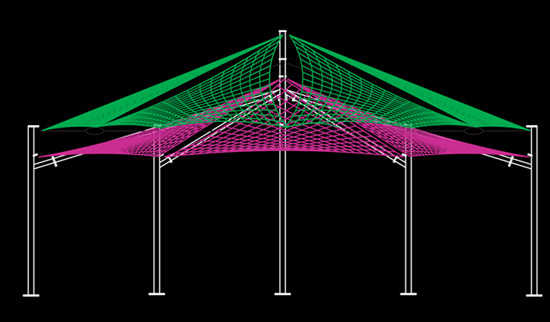
Image courtesy Shade Structures, Inc.
The fabric structure begins with an idea, which will determine its form.
Visualization. But what will the structure actually look like? A typical CAD program will not be able to properly “shape” fabric. Rather, sophisticated 3D/CAD rendering and animation software enables clients to better understand the fundamentals of shape, form and function of the desired fabric structure, with a 3D version of a concept suitable for construction. Animation in CAD format can represent the actual final product and is the starting point for converting the concept into reality. Physical models, in which material is stretched over wire frames, allow designers and clients to “get inside” the structure, and are often used for presentations and fund raising.
Geometry and Structural Analysis. The CAD model is imported into specialty non-linear engineering software which enables analysis that will determine if the structure is stable, whether the membrane is shaped correctly, and if it is over-stressed or in a position to pond. Further, it can provide sufficient information on the sizing and weight of the elements for an accurate cost estimate. Once the required centerline geometry of the structure has been determined, it is modeled in 3D using highly specialized software to define a final equilibrium shape that meets the requirements of the client. The equilibrium shape is then analyzed under various loading conditions to determine the steel, cable and fabric requirements.
Membrane Engineering. The fabric requirements are carefully engineered in terms of seam layout and membrane details.
Biaxial Testing. This is a test where a small sample of fabric from the roll being utilized for a specific project is tested to ensure it has the assumed industry standard tensile properties.
Compensation Factor. Typically, architectural membranes elongate less than 1 percent over the life of the fabric. When the fabric is received for production, it is in a relaxed state. At this point, loads are applied in specialty software to determine the amount the fabric will “creep” from a relaxed into a tension state. This compensation factor is applied during the cutting of the fabric to the desired shape.
Membrane and Hardware Details. The engineering and analysis process also includes determining the type, size, capacity etc., of components that will be utilized in fabric structures where they connect to a structural element such as columns or buildings. These membrane details can include items such as fabric corner reinforcements, perimeter cable pockets or cuffs, membrane plates, turnbuckles, clamping and cables, etc.
“Nesting” Panels. Fabric comes in rolls of certain widths. In order to arrange the patterns in the most efficient way and to avoid unnecessary fabric waste, nesting is necessary. This is a process in which the designed fabric patterns are superimposed on pieces that represent the fabric roll, and the size and orientation are manipulated to achieve the best layout possible.
Patterning. The fabric shape is then patterned. Patterning is the art of representing three-dimensional shapes by connecting a series of flat, two-dimensional templates into one fabric assembly. The size and shape of the panels are determined by engineers using specialized software, and then provided to fabricators who cut and assemble the fabric. Selected to meet the specific project requirements, fabrics have varying degrees of translucency, light reflectivity, UV and weather protection, and non-combustibility. Certain fabrics offer self-cleaning surfaces and all are easily maintained to preserve their appearance and ensure a long life. Strong, durable seams applicable to the individual fabric are critical, and include heat sealing, radio frequency (RF) sealing and sewn seams utilizing heavy-duty thread, depending on the membrane selected for the structure. Advanced computer controlled cutting technology provides precision load analysis and tight tolerances.
Fabrication of Membrane/Fabric, Attachment Components and Structural Supports. Based on fabrication drawings, material is purchased, actually fabricated and packaged for delivery to the site.
At this point, steel shop drawings should be completed by steel fabricators and reviewed by a project engineer and/or designer prior to commencing the actual manufacturing of the steel components. Some of the more complex projects require installation engineering and input before the construction process begins, and may include things such as specialized hydraulic tensioning components, rigging design and sequencing plans. Steel fabrication should be certified by the International Accreditation Service (IAS) board as meeting, or exceeding, the highest standards in the steel fabrication industry. Some steel plants are equipped with state-of-the-art machinery, including robotic welding, computerized roll benders, custom swagers, massive sand blast booths and powder coat ovens and booths, with highly specialized tools and equipment used to cut raw steel and fabricate plates.
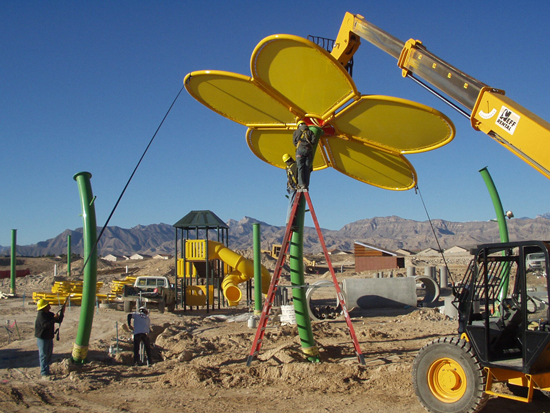
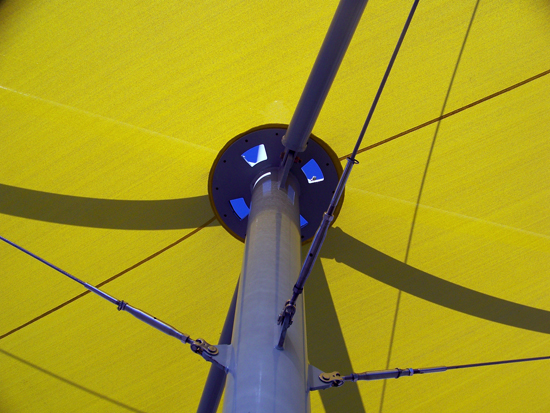

Photos courtesy of Shade Structures, Inc.
The proper components and details are critical to the successful installation of a fabric structure.
Load requirements will help determine the type of details and components that are required for support, and whether they are off-the-shelf or custom made. The forms are derived from the bridge building and yacht racing industries, making them both ultra strong and light weight. Several basic forms come into play with fabric structures. A base plate serves as a connection to the ground, wall or the adjacent structural system. It is welded to the bottom of a compression member. Mast or arch structures will require cleats, tabs and gussets, along with struts and bale rings for maximum stability. It is important to note that the membrane plate is one of the most critical components to design and produce. It is the link from the membrane to the structural support and is used to accept the membrane catenary cables.
Permitting. Ease of obtaining a permit will depend on the city and county in which the structure must be installed. Most cities do require a building permit for the shade structures. Quality fabric structures should be fully engineered to meet or exceed the local building code requirements. Typically the turnkey provider will assist in obtaining the necessary documents to obtain a permit.
Installation. The complexity of the installation depends on the intricacy of the structure and a number of other issues. Some fabric structures do not require permanent foundations and need minimal site preparation. That said, installation is a very important part of the process and essential to the service life and functionality of the fabric structure. The erection procedure must be considered and often takes into consideration site surveys, site preparation, reports on soils and water tables, and weather conditions, particularly wind gusts. Generally they are designed and engineered to meet the wind load requirements of the area in which they are to be used, which normally range from 90 to 125 mph.
Site and soil conditions will determine the foundation configuration. Spread footers are used where the soil is unstable and more support is necessary, such as in areas of high water tables, sugar sand, coral rock, or where a soils analysis indicates other unfavorable conditions. Generally, “uplift” governs the load values of fabric structures. By using a pier foundation, the soil friction values can help reduce its size. Spread footings are constructed of concrete and often reinforced with rebar or steel for additional support. Because of their size, they require additional concrete, rebar and dirt removal, and thus spread footings are generally more expensive than other types of foundations.
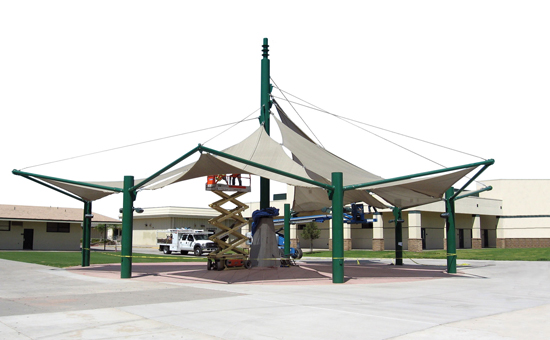
Photos courtesy of Shade Structures, Inc.
The complexity of the installation depends on the intricacy of the fabric structure.
Proper mounting types must also be considered. In a direct embed situation, there will be a surface mount and/or a recessed base plate. If these elements are used, anchor bolts are required.
It is also advisable to have a plan for unloading materials, installation and tensioning in order to minimize delays and potential problems on site.
All this being said, with the many facets and integrated details of a tensile fabric structure, and in order to maximize results and help assure a successful project, an experienced and qualified design-build tension fabric company should be involved in the project from the onset of conceptual design, and should continue to be involved throughout the entire process, including final installation.
Fabric Choices—Finding the Right Material
Architects may want to review the options in terms of several environmental parameters including natural ventilation, reduction in direct sunlight, heat loss or gain, admittance of natural light and contribution to LEED credits. Often the choice of fabric will be climate dependent. For example, in a mixed and hot humid climate, the appropriate approach would encompass rain protection, passive cooling, shading, ventilation, day lighting and reduced heat gain. In snow areas, the slope and snow load of the structure must be considered.
Generally speaking, architectural fabrics have a woven substrate that is finished with a coated material. This substrate is what gives fabric its tensile strength. Following are the most popular fabrics on the market today.
Teflon coated fiberglass (PTFE). This product is a woven fiberglass substrate, and is used for large-scale permanent structures with a required life span of more than 25 years. The Teflon coated material comes to the site as buff in color but bleaches to a milky white over time by exposure to UV rays, typically four to eight weeks. The biggest drawback of the Teflon coated material is its stiffness; the material is brittle and must be handled very carefully to avoid breaking the fibers. Advantages include its longevity, self-cleaning attributes and fire rating. In most states, permanent, totally enclosed structures require “non-combustible” or Class A ratings according to building codes. The most recognized and accepted material used for architectural application is Teflon coated fiberglass or PTFE.
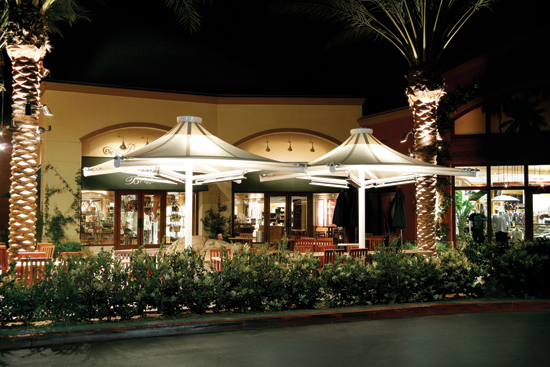
Photo courtesy of Shade Structures, Inc.
PTFE fabrics are used for permanent structures requiring long life spans.
It is critical to note that many factors can dramatically influence a project’s pricing, including economies of scale, accessibility, site conditions, equipment requirements and engineering requirements, to name a few. Hence the following costs are presented for general consideration relative to the listed fabrics and for reference only, and should NOT be used for project-specific budgeting without an experienced industry professional. The stated range is based on the fabric area rather than the plan area. PTFE pricing can average between $85 and $165 per square foot.









